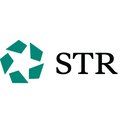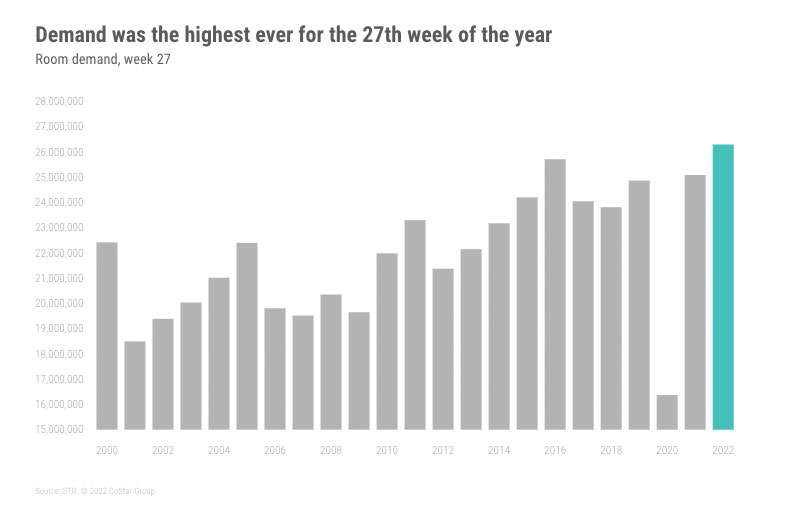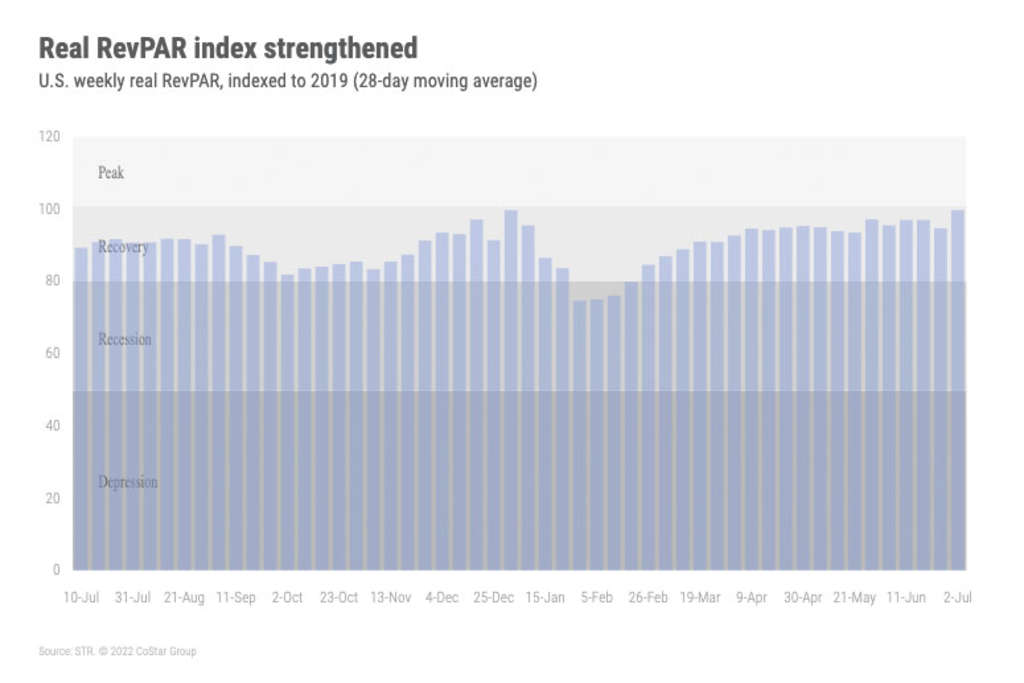Market Recovery Monitor - 2 July 2022
U.S. hotel occupancy fell 4.9 percentage points from the previous week and came in at 67.3% for 26 June-2 July (week 27). While that might seem alarming, it is important to note this type of decline is normal for the Fourth of July holiday. Since 2000, the Fourth of July or the holiday observance (federal holiday) has fallen on a Monday seven times, including last year and in 2016. In each case, occupancy in the week before the holiday fell by more than four percentage points with most of the losses beginning on Wednesday and continuing into the weekend. While much is being written about inflation and a potential recession, this latest decline is more about normal demand patterns versus a reaction to the aforementioned macro conditions. Additionally, demand and occupancy are also likely to come in lower for the week containing the holiday before strengthening in the remaining weeks of July. Nominal average daily rate (ADR) also retreated, down 2.5% from the previous week, however, it was 20% higher than in 2019 and 12% greater than a year ago. Nominal revenue per available room (RevPAR) dropped 9.2% week on week but was also above 2019 (+23%) and 16% higher than last year.
There is no doubt that demand and occupancy fell in the week, but context is important given increasing economic concerns. Looking strictly at week 27, this year’s demand was the highest ever recorded (26.3 million) since 2000. The previous high was achieved in 2016 (25.7 million). In 2019, when the holiday was on a Thursday, demand was 24.9 million. It is also important to note that this year’s holiday spilled over into a second week. But, regardless of whether the Fourth has fallen into two weeks, demand has always dropped when comparing week 27 versus week 26. Thus, what we observed this past week was normal, and the level of the week-on-week decrease (-1.9 million) was not out of the range seen previously, which has been between -1.5 million (2005) and -4.5 million (2018). The only time demand hasn’t fallen from week 26 to week 27 was in 2020, when it increased 31,000. That was of course during the early months of the pandemic, when seasonal patterns had been thrown out the window. Finally, occupancy for the week has averaged 65% and ranged from a high of 74% in 2000 to a low of 58% in 2009—excluding the extreme low seen in 2020 (46%). While demand reached an all-time high for week 27, the week’s occupancy was the fifth highest for that period, lowered by increased supply over the many years.
As compared with all weeks since the start of the pandemic, the week’s demand was the ninth highest with occupancy ranking 11th. After three weeks with the nation’s highest market occupancy, Alaska was surpassed by Denver (86%). Alaska (85%) was second, followed by Portland, OR (84%), and Oahu (83%). The lowest occupancy levels were in Tucson (51%) and Tulsa (52%), but each was above 2019 comparisons. Most markets, 66%, were above their 2019 occupancy levels, but that is likely because in 2019, the Fourth of July holiday fell on Thursday, affecting demand that entire week and making for an easy comparison. Overall, only three markets reported their highest demand level since the start of the pandemic: Denver, Oahu, and Indianapolis. Comparing only to previous week 27s, 45 markets saw their highest demand levels, including Orlando, Chicago, Atlanta, Dallas, and Houston.
Occupancy in the Top 25 Markets dropped to 70% and dipped to 66% elsewhere. In central business districts (CBDs), occupancy fell to 70% from 74% in the previous week. Nine of the 20 CBDs reported occupancy above 70%, led by Seattle CBD (80%) and San Diego (80%).
Airport delays and cancellations likely lifted demand in some markets, including Denver, as the Denver Airport/East submarket posted the highest submarket occupancy (90%) in the nation. Occupancy in submarkets with “airport” in the name ranged from that high of 90% to a low of 52% (Tulsa Airport/North) with most airport locations reporting a week-on-week decrease. The largest submarket weekly demand increase was seen in New Orleans CBD/French Quarter, where occupancy reached 79%. Atlantic City saw the second largest demand gain of any submarket with occupancy topping 74%.
Nominal ADR came in strong once again despite the week-on-week decrease. The week’s result was the fifth highest weekly value going back to 2000. The four higher values all came recently in 2022, with three of the four occurring in the preceding three weeks. Missouri South, McAllen/Brownsville, Massachusetts Area, Georgia South, Buffalo, and Wisconsin South set market records for their nominal ADR. Inflation-adjusted (real) ADR also decreased week over week but remained above the 2019 comparable for a fourth consecutive week. Of the four, this week’s result was the highest at 5% above the 2019 comp. Since the start of the year, real ADR has surpassed 2019 comps 11 times. No market set an ADR record in real terms, and only two saw pandemic-era highs (Denver and Massachusetts Area).
Weekday (Sunday-Thursday) nominal ADR (-2.7%) fell more than the weekend (-1.6%). Real weekday and weekend ADR was above 2019. This was only the second time of this occurrence on weekdays, which we attribute to the easy 2019 comparison. Weekend real ADR has been higher than in the comparable weeks of 2019 for the past 20 weeks. Real ADR in the Top 25 Markets was also above 2019 for only the third time this year.
With week-on-week occupancy and nominal ADR falling, nominal RevPAR fell sharply (-9.8%) from the prior week, but it was still the ninth highest ever recorded by STR since 2000. The index to 2019 also reached the second highest level since the start of the pandemic (123). Real RevPAR dropped, however, it remained above US$90 for a fourth consecutive week and was 8% higher than in the matching week in 2019. This was only the second time that real RevPAR surpassed 2019, with both occurrences positively impacted by a holiday shift.
Looking at the past 28 days, 57% of the 166 STR-defined U.S. markets reported real RevPAR above what it was in 2019. Another 42% were in “recovery” (RevPAR indexed to 2019 between 80 and 100). Just two markets, Portland, OR and New Mexico South remained in “recession” (RevPAR indexed to 2019 between 50 and 80).
Around the Globe
Occupancy outside the U.S. also fell, but by only 0.8 percentage points (week on week) to 65%. This was the second highest level since the pandemic began, with the highest occupancy seen in the previous week. Strong demand growth was seen in China, the U.K., and Sweden. On the flip side, Japan, Germany, and Spain recorded sharp declines this week with occupancy in Japan and Germany falling by more than five percentage points. Global nominal ADR crept up a bit (+1%), but nominal RevPAR declined (-0.2%) due to the decrease in occupancy. Despite that decrease, nominal RevPAR—like occupancy—was at the second highest level since the start of the pandemic.
Among the top 10 countries based on supply, the U.K. had the highest weekly occupancy at 85% followed by France (77%) and Italy (74%). While China saw strong demand growth this week, the country’s occupancy (57%) remained weak and at the bottom of the top 10 countries.
At a market-level, occupancy was the highest in Coventry (92%), Dublin (92%) and London (92). Forty-nine of the 342 markets tracked by STR reported occupancy above 80% with another 95 posting a level between 70% and 80%.
The highest weekly nominal RevPAR was seen in Sanya, China (+65%) with 22 markets observing weekly growth above 20%. Over the past 28 days, 60% of global markets had a nominal RevPAR above 2019. This is the highest percentage since the start of the pandemic. Six markets are still in “depression” (RevPAR indexed to 2019 below 50) and 43 are in “recession.”
Big Picture
The big takeaway from the data is that the decline in this week’s performance was normal for the week of or around the Fourth of July and has occurred since STR began weekly benchmarking in 2000. At the same time, there is much to be concerned about and the future is murky at best. However, the industry continues to perform well, and the remaining weeks of the summer should continue to be robust with the industry hitting is annual weekly peak by the end of July. Thereafter, demand will begin to soften as the resumption of schools begin.
About STR
STR provides premium data benchmarking, analytics and marketplace insights for the global hospitality industry. Founded in 1985, STR maintains a presence in 15 countries with a corporate North American headquarters in Hendersonville, Tennessee, an international headquarters in London, and an Asia Pacific headquarters in Singapore. STR was acquired in October 2019 by CoStar Group, Inc. (NASDAQ: CSGP), the leading provider of commercial real estate information, analytics and online marketplaces. For more information, please visit str.com and costargroup.com.










